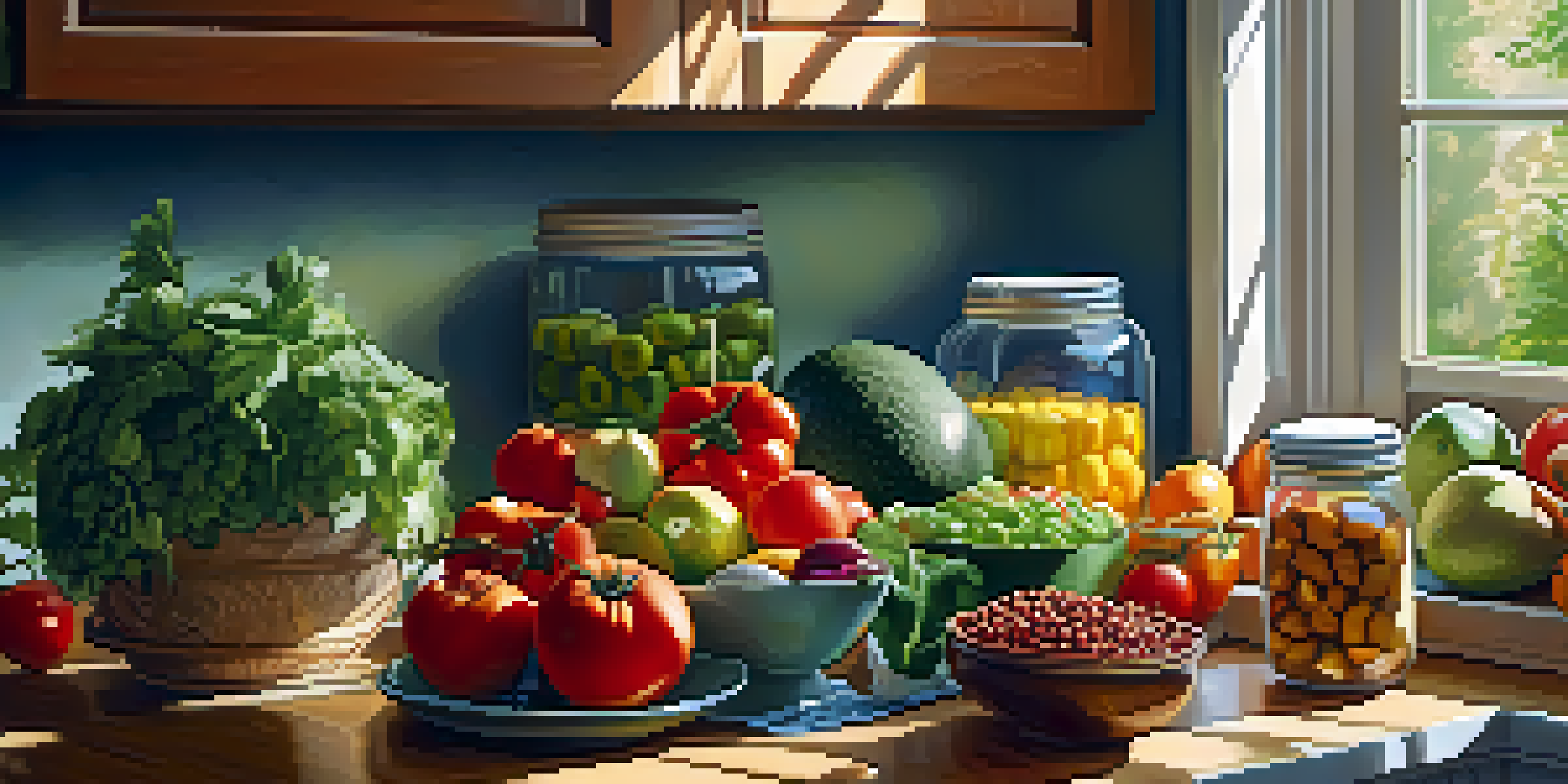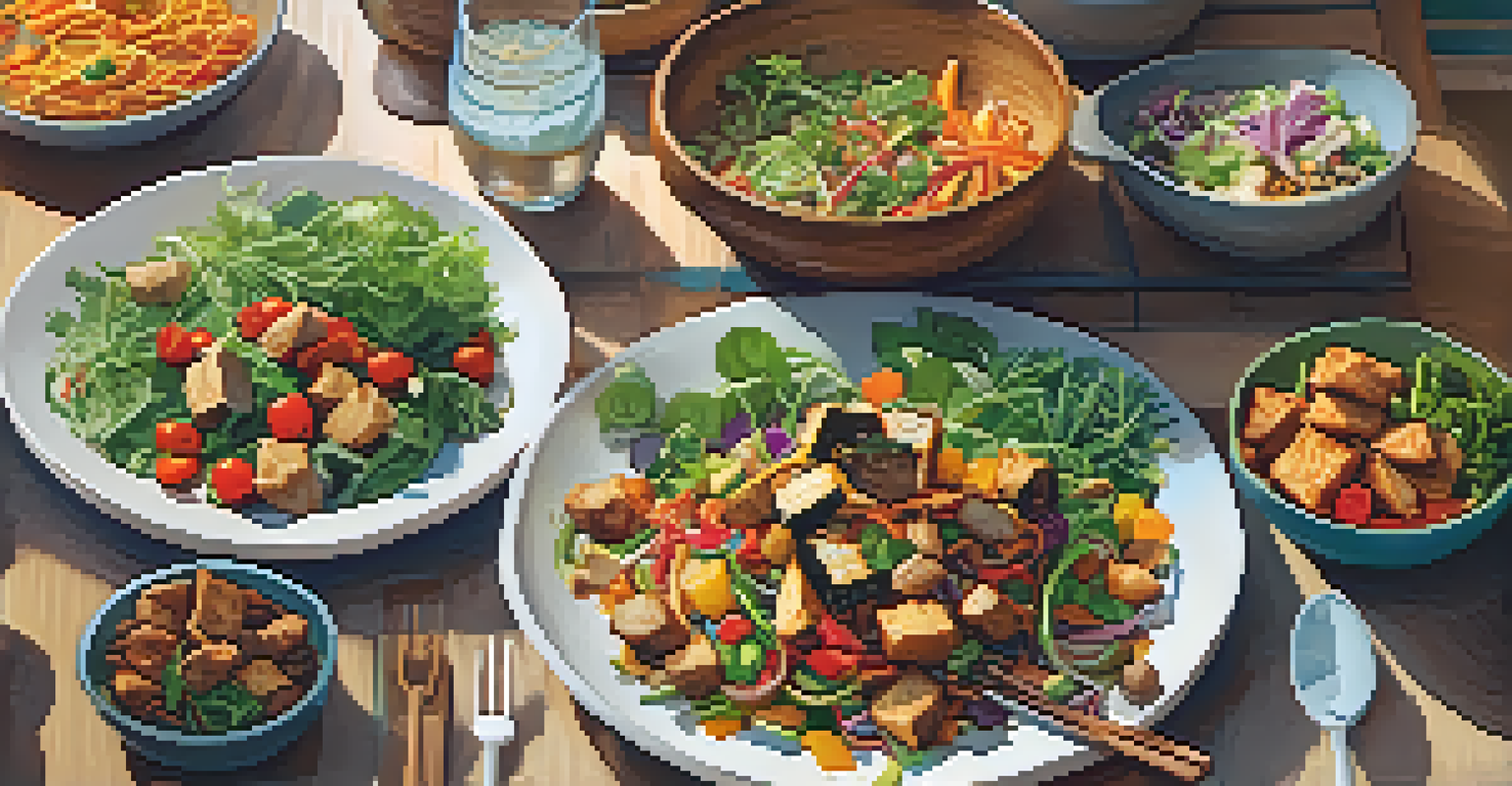Storage Tips: How to Keep Vegan Foods Fresh and Safe

Understanding Vegan Food Preservation Basics
To keep vegan foods fresh and safe, it's essential to understand the basics of food preservation. Unlike animal products, many plant-based foods are highly perishable and need special attention. Familiarizing yourself with how different foods spoil can help you take proactive measures.
The kitchen is a place where creativity and safety must coexist, and that's especially true in vegan cooking.
For instance, fruits and vegetables have varying shelf lives depending on their type and ripeness. Some, like avocados, can quickly spoil if not stored correctly, while others, such as carrots, can last a bit longer. Knowing these nuances allows you to plan your meals effectively.
Ultimately, the goal is to minimize waste and ensure that your meals are both delicious and safe to eat. By understanding food preservation, you set yourself up for success in enjoying a vibrant vegan lifestyle.
Ideal Storage Conditions for Fresh Produce
Fresh produce is the cornerstone of any vegan diet, but it can also be tricky to store. Most fruits and vegetables thrive in cool, dark places, making your refrigerator the ideal environment. However, not all produce should go in the fridge; for example, tomatoes and bananas prefer room temperature.

To maintain freshness, consider using perforated plastic bags or breathable containers, which allow air circulation while retaining moisture. This method helps avoid spoilage while keeping nutrients intact. In addition, be sure to separate ethylene-producing fruits, like apples, from sensitive vegetables to prevent premature ripening.
Store Produce Properly
Understanding the ideal storage conditions for fresh fruits and vegetables helps maintain their freshness and prevent spoilage.
Regularly check your produce for any signs of spoilage, and remove any affected items to prevent the spread of decay. Taking these simple steps can significantly extend the life of your fruits and veggies.
Best Practices for Storing Grains and Legumes
Grains and legumes are staples in many vegan diets, and proper storage can keep them fresh for an extended period. The best way to store these items is in airtight containers placed in a cool, dark pantry. This prevents moisture and pests from ruining your pantry essentials.
Waste is a terrible thing to waste, especially when it comes to food. Get creative with leftovers!
For longer storage, consider vacuum-sealing your grains and legumes. This method removes air, which can lead to rancidity, especially in whole grains. Additionally, labeling your containers with purchase dates can help you keep track of freshness and rotate your stock.
By following these best practices, you can ensure that your grains and legumes remain nutritious and flavorful for all your vegan recipes.
Proper Handling of Vegan Dairy Alternatives
Vegan dairy alternatives, such as plant-based milks and cheeses, require careful handling to stay fresh. Once opened, plant-based milks should be refrigerated and consumed within a week to ten days. Always check the packaging for specific guidelines, as different brands may vary.
When it comes to vegan cheeses, it's crucial to keep them tightly wrapped or stored in airtight containers to prevent them from drying out. Some vegan cheeses can also develop mold, so be vigilant and discard any that look questionable.
Practice Cleanliness in Storage
Maintaining a clean kitchen and storage environment is essential for preventing cross-contamination and ensuring food safety.
By practicing proper handling techniques, you ensure that your vegan dairy alternatives remain safe to consume and delicious in your favorite dishes.
Freezing Tips for Long-Term Vegan Food Storage
Freezing is an excellent option for prolonging the life of vegan foods, especially fruits, vegetables, and prepared meals. However, not all foods freeze well, so it's essential to know what can withstand the cold. For instance, berries and chopped vegetables freeze beautifully, while some leafy greens may become mushy.
When freezing, it's best to use freezer-safe bags or containers to prevent freezer burn. Remember to label everything with the date to keep track of how long items have been stored. Additionally, consider portioning out meals before freezing, which makes it easier to defrost only what you need.
By utilizing your freezer wisely, you can enjoy the benefits of meal prep while ensuring your vegan foods remain fresh and safe.
The Importance of Cleanliness in Food Storage
Maintaining cleanliness in your kitchen is crucial for safe food storage practices. Before you store any food, make sure your containers, countertops, and hands are clean to prevent cross-contamination. This step is especially important when handling raw produce or cooked meals.
Regularly cleaning your fridge and pantry can also help eliminate potential sources of contamination. Wipe down shelves and check for expired items, as a clean storage environment not only keeps your food safe but also encourages you to eat healthy.
Utilize Leftovers Creatively
Finding innovative ways to use leftover vegan ingredients not only reduces waste but also enhances your culinary experience.
By prioritizing cleanliness, you create a safe space for your vegan foods, reducing the risk of foodborne illnesses and spoilage.
Understanding Expiration Dates and Food Safety
Expiration dates can be confusing, but understanding them is vital for food safety. Many vegan products have 'best by' or 'use by' dates that indicate peak quality rather than safety. Familiarize yourself with these terms to make informed decisions about your food.
Always trust your senses; if a food item smells or looks off, it's best to err on the side of caution and discard it. Additionally, practice the 'first in, first out' rule by using older items before newer ones to minimize waste.

By being knowledgeable about expiration dates and food safety, you can confidently enjoy your vegan foods without the worry of spoilage or health risks.
Creative Ways to Use Leftover Vegan Ingredients
Using leftover vegan ingredients is not only eco-friendly but also a fun way to experiment in the kitchen. Instead of letting items go to waste, think creatively about how to incorporate them into new dishes. For example, leftover vegetables can be blended into smoothies or added to soups.
You can also transform stale bread into croutons or breadcrumbs, giving new life to your pantry leftovers. Another idea is to create a stir-fry or grain bowl, where you can mix and match various ingredients for a hearty meal.
By embracing creativity, you can reduce waste and enjoy a diverse array of flavors in your vegan cooking.